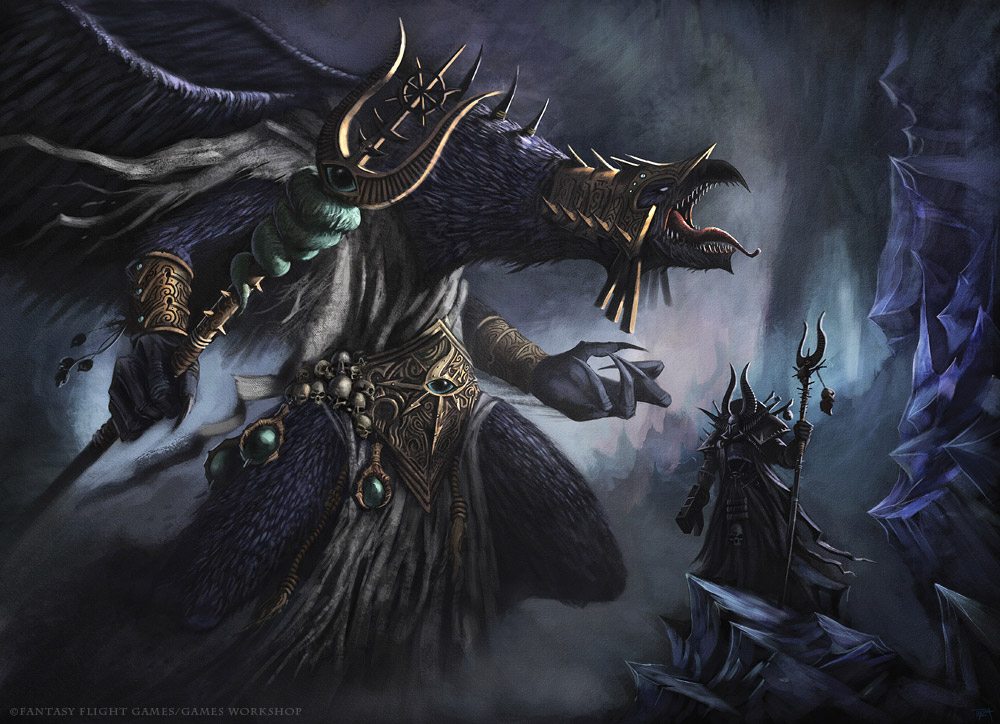
While it seems that half the internet is either rejoicing or despairing at every new twist in 9th ed (or even at the rumor of a twist) I have been chewing through some of the new narrative rules that have leaked out. I have divided them into three different sections: The Good, The Bad and The Ugly.
The Good:
- I am going to cheat here a bit, right off the bat, overall I think the whole system is solid. I like the way they have balanced out the standard campaign rules with ones that add more flavor (such as maintaining a combat roster. I think one of the greatest achievements of this rule set is the ability to create genuinely exciting in-game moments, and characters that have an interesting story.
- Missions: I love some of these missions. While I haven’t play tested them yet, just looking at the rules get me excited. I am also pumped that they brought back some of the old flavorful missions from past editions, most notably: Ritual and Assassinate.
- Starting limitations: I love the fact that (unless you start with a named character) you must pay additional requisition points for relics and warlord traits. As I said above, this can be a great way to build up a backstory for a character and watch them progress through a campaign (in my eyes one of the best parts of any narrative event)
- Experience and Casualties: In my campaigns I have always struggled to balance the urge to give units upgrades and how to handle casualties. One the one hand, upgrades add a lot of flavor and can make a unit fulfill a unique battlefield role. One the other hand, they can be abused by unscrupulous players to create a game wrecking murderball of a unit. Casualties are another tricky issue. As an organizer I want to have consequences for my players to encourage them to play narratively but at the same time it can turn games into a whack-a-mole-fest as each player tries to delete his opponent’s most valuable units. I think GW has walked the line well in this rule set and showed a lot of wisdom in by giving the players the choice in how they want their unit to suffer consequences
The Bad
- The only bad thing I can see in this ruleset is: there is a lot of bookkeeping. Requisition points! Crusade Points! Agendas! Blessings! Experience points! In building this ruleset Games Workshop obviously decided to err on the side of depth, throwing a lot of important facets that players will need to track throughout and after the game. As an organizer this can be a bit of a headache as I have seen players frequently forget to track these items in the heat of a game and then try to piece together what happened afterwards. As someone who has struggled to maintain a cohesive player group through even a short campaign, I worry some of these rules will cause players eyes to glass over or will intimidate them from joining a campaign. I think that organizers might benefit from pruning some of the rules (especially early on) depending on the needs and desires of their player base.
The Ugly:
- The only thing I have for this section is the rule on scoring points based on painting. I am certain this isn’t in the narrative rules, but I did want to address it as think this rule could be incorporated in a way to reward players in narrative campaign. While the rule itself is proving controversial (I believe it is a good rule as it can provide an impartial boon to smaller clubs who are dominated by a certain kind of player) I think you could incorporate this rule to award experience points to every unit in a player’s roster that is painted, or you could limit battle traits to only be available to fully painted units. I think that providing incentives generally works better then doling out punishments and incorporating this rule could be a good way to encourage players to paint their armies.
So that is all I have for this article. I am very excited to see what opportunities this new system will provide, and I am already starting my plans for the first campaign of 9th Edition. What about you? Any thoughts on what you do or do not like about the new Narrative rules?
And remember, Frontline Gaming sells gaming products at a discount, every day in their webcart!




It’s clear that the Crusade rules have been written by people used to running campaigns, especially those ones where not every-one turns up every Tuesday night!
I like the fact that you can be in a Crusade playing against folks who aren’t and then record it in the shiny new journal (better than pieces of paper to leave in the pub or on the Bus). Every game matters then! The book-keeping builds on “Kill Team”, “WarCry” or narrative 1000 tables of old.. it’s not too onerous.
The painting rules should level out several issues. How many times on these pages did folks have to be reminded before the LVO 2020 that a chaplain dreadnought wasn’t just a bad, black paint job? How many times have we faced “grey plastic” or bare metal/resin in a competition? If they can’t be bothered to do the painting part of the hobby what is the likelihood they’ve read the rules in a balanced manner?
Same odds as painters, in my experience.
The biggest advantage of requiring painting is that it make the game much clearer and easier to see what is happening. But the concept that non painters are WAAC is pretty much disproven by playing in any country where painting requirements are common.
In my experience, the person who shows up with a beautifully painted army, actually knows the rules *less*, not more. Not always the case, but too often I find they only know their army specific rules, and don’t understand what other armies can do.
That being said, I am a fan of the painting req. As someone who likes painting the least in this hobby, it will be a good motivator for me to paint more things!
As far as Crusades go, my thought is to give each unit +1 xp for the first game they are in and fully painted… should help offset the newly-painted-model-syndrome.